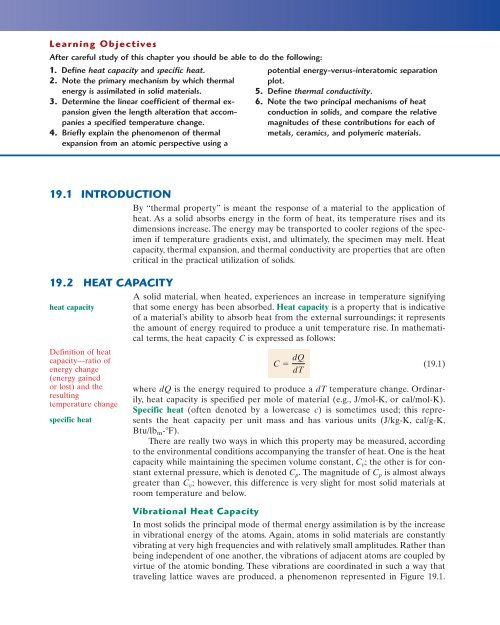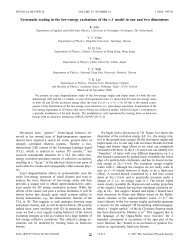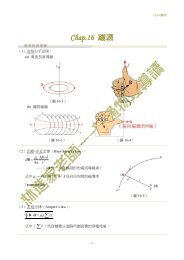Chapter 19 Thermal Properties
Chapter 19 Thermal Properties
Chapter 19 Thermal Properties
You also want an ePaper? Increase the reach of your titles
YUMPU automatically turns print PDFs into web optimized ePapers that Google loves.
Learning Objectives<br />
After careful study of this chapter you should be able to do the following:<br />
1. Define heat capacity and specific heat.<br />
2. Note the primary mechanism by which thermal<br />
energy is assimilated in solid materials.<br />
3. Determine the linear coefficient of thermal expansion<br />
given the length alteration that accompanies<br />
a specified temperature change.<br />
4. Briefly explain the phenomenon of thermal<br />
expansion from an atomic perspective using a<br />
potential energy-versus-interatomic separation<br />
plot.<br />
5. Define thermal conductivity.<br />
6. Note the two principal mechanisms of heat<br />
conduction in solids, and compare the relative<br />
magnitudes of these contributions for each of<br />
metals, ceramics, and polymeric materials.<br />
<strong>19</strong>.1 INTRODUCTION<br />
By “thermal property” is meant the response of a material to the application of<br />
heat. As a solid absorbs energy in the form of heat, its temperature rises and its<br />
dimensions increase. The energy may be transported to cooler regions of the specimen<br />
if temperature gradients exist, and ultimately, the specimen may melt. Heat<br />
capacity, thermal expansion, and thermal conductivity are properties that are often<br />
critical in the practical utilization of solids.<br />
<strong>19</strong>.2 HEAT CAPACITY<br />
heat capacity<br />
Definition of heat<br />
capacity—ratio of<br />
energy change<br />
(energy gained<br />
or lost) and the<br />
resulting<br />
temperature change<br />
specific heat<br />
A solid material, when heated, experiences an increase in temperature signifying<br />
that some energy has been absorbed. Heat capacity is a property that is indicative<br />
of a material’s ability to absorb heat from the external surroundings; it represents<br />
the amount of energy required to produce a unit temperature rise. In mathematical<br />
terms, the heat capacity C is expressed as follows:<br />
C dQ<br />
dT<br />
(<strong>19</strong>.1)<br />
where dQ is the energy required to produce a dT temperature change. Ordinarily,<br />
heat capacity is specified per mole of material (e.g., J/mol-K, or cal/mol-K).<br />
Specific heat (often denoted by a lowercase c) is sometimes used; this represents<br />
the heat capacity per unit mass and has various units (J/kg-K, cal/g-K,<br />
Btu/lbm-F). There are really two ways in which this property may be measured, according<br />
to the environmental conditions accompanying the transfer of heat. One is the heat<br />
capacity while maintaining the specimen volume constant, Cv; the other is for constant<br />
external pressure, which is denoted Cp. The magnitude of Cp is almost always<br />
greater than Cv; however, this difference is very slight for most solid materials at<br />
room temperature and below.<br />
Vibrational Heat Capacity<br />
In most solids the principal mode of thermal energy assimilation is by the increase<br />
in vibrational energy of the atoms. Again, atoms in solid materials are constantly<br />
vibrating at very high frequencies and with relatively small amplitudes. Rather than<br />
being independent of one another, the vibrations of adjacent atoms are coupled by<br />
virtue of the atomic bonding. These vibrations are coordinated in such a way that<br />
traveling lattice waves are produced, a phenomenon represented in Figure <strong>19</strong>.1.

















